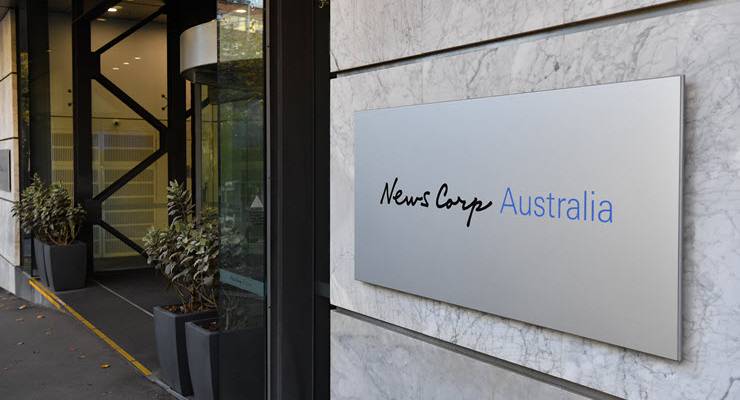
For an hour on Friday morning the elephant sat in the back of the global room as News Corp released its fourth quarter and 2019-20 results.
In a teleconference with analysts this morning, chief executive officer Robert Thomson and chief financial officer Susan Panuccio avoided the huge dab of red in the shape of a US$1.55 billion loss (A$2.1 billion), as well as the elephant in the room.
Even though he had walked away from the family company just six days ago, none of the handful of analysts on the call asked a single question about James Murdoch’s decision to resign or the disagreements he mentioned in his two-paragraph departure letter.
As Thomson again made a big play about quality and integrity in News Corp’s journalism, especially at The Wall Street Journal and the London Times and Sunday Times, James Murdoch’s comments still didn’t rate a mention.
An unknown number of journalists listened on, unable to ask a question — they surely would have.
So the impact of COVID-19 was raised, the impact of massive cost cuts across the company talked about, as were the problems of forecasting the current quarter, let alone 2020-21, and subsidiary issues like dealing with digital platforms.
The failure to ask at least one question by analysts from the likes of Macquarie, Morningstar and Huber Research was amazingly bone-headed and insular.
There would have been a lot of James Murdoch’s influence on the board in such an eventful year.
There were the decisions to sell Unruly and News America Marketing, to cut hundreds of jobs from the foundation Australian newspaper businesses, to close or revamp 112 Australian newspapers, and to lop hundreds of jobs at Foxtel and slash spending elsewhere. In the Murdoch style, all of those would have been board decisions.
Those losses were due to the impact of COVID-19 and the impact on newspaper and Foxtel advertising and circulation revenues, costs — especially redundancies — and the massive impairment at Foxtel in the March quarter of almost US$1 billion (more than A$1.2 billion).
There were some positives though — for the first time, News Corp separated the Dow Jones Co as a reporting group. It showed higher revenues and pre-tax earnings for The Wall Street Journal, Barron’s and Marketwatch.com, while the Harper Collins book publishing business withstood COVID-19’s depredations. Real estate in the US (Move.com) and Australia (REA) did OK but took hits, and Foxtel is a mess that is being cleaned up.
News Corp’s results were not pretty for the quarter and the year — that was to be expected given the dramatic impact of COVID-19 and associated cost cuts that were taken by a nervous management, especially in the final four months of the financial year.
Scattered throughout the presentation were signs of the brutality.
Panuccio let slip that News Corp cut staff numbers by 7% across the year (excluding the sold assets, Unruly and News America Marketing).
Thomson said News Corp Australia “unfortunately implemented hundreds of redundancies” because of the restructuring that saw 112 local and regional papers axed, revamped and merged or turned into digital only websites. And Panuccio said that Foxtel had “cut its headcount by 17% in its restructuring which will save at least $US100 million in costs”.
Total revenues for the year fell 11% to US$9.01 billion, which News Corp said reflected a 4% negative impact from COVID-19, as well as selling off News America Marketing.
The net loss for the full year was US$1.55 billion compared to net income of US$228 million in the prior year, reflecting US$1.69 billion of non-cash impairment charges, primarily related to Foxtel and News America Marketing.
Foxtel stood out because while there were signs of improvement, with subscriber numbers rising for the Kayo sports service and the new Binge general streaming platform, total subscriptions still fell over the year. Total Foxtel household and commercial subscribers at June 30 fell to 1.99 million, down from 2.37 million at June 2019, a drop of 12%.
In its now usual fashion, News Corp and Thomson gave updated figures for the streaming services as of August 4 (five weeks after balance date) but not for the core household and broadcast subscriber number.
The August 4 update said that subscribers to Foxtel’s over the top streaming services, Kayo, Foxtel Now and Binge, had “passed one million”. But even if you add that to the number of household and commercial subscribers of 1.99 million it still falls short of the total number of subscribers for June 30 2019 (3.21 million). Spinning to the last second. So very News Corp.








“News Corp reports massive loss and job cuts in annual results”
At last some good news. That has got to be a step in the right ( sorry “correct”) direction.
‘Foxtel had “cut its headcount by 17% in its restructuring which will save at least $US100 million in costs”.’
So the $40M that Australian taxpayers have donated to Foxtel in the past 3 years – via the Coalition govt – hasn’t made a dent? What a shame, instead perhaps it may have saved some of the 112 local papers…
News Corp reports massive loss and job cuts in annual results. The good news keeps on coming. What else can I say, but HOORAY!!!
Please tell me that the cost cutting measures will include shutting down Sky-after-Dark and pensioning off those dreadful talking heads.
They could run cartoons and get their audience numbers back up.
This is bad news for the ABC.
It is part of Liberal party belief that government should not compete with an efficient private sector (by being more efficient than one). This decline in News Corp fortunes will only provide further justification for cuts to the ABC.
So, I would urge any supporter of the ABC to buy News Corp newspapers. To appease any reluctance to do this, I would suggest these newspapers could be put to good use by reducing the rush to buy toilet paper.